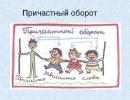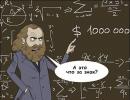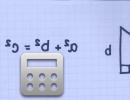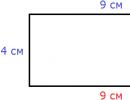Abstract on the topic of the letter d. Abstract of an open lesson on teaching literacy in the preparatory speech therapy group for school “Sounds, and the letter D. Repetition of what has been learned about sounds
Municipal budgetary educational institution
Initial comprehensive school the village of Durgen, Tandinsky kozhuun, Republic of Tyva
Lesson summary literary reading
(literacy education)
1 class
Subject: « Consonants [ d ] , [ d' ] , letters D, d »
Teacher: Khuvaa Chechek Sanyshirovna
Literary reading 1 class
Subject:" Consonants [ d ] , [ d' ] , letters D, d »
Lesson type: discovery of new knowledge
Target: introduce students to the new letter D, d, denoting consonant sounds [d], [d "],highlight consonants in speech [d], [d ']
Tasks:
Educational: mastering the ability to characterize sounds, the formation of the skill of reading words, sentences with learned letters.
Developing: develop coherent oral speech, memory, fluent syllabic reading skills with a transition to reading whole words. Enrich students' vocabulary.
Educational: to bring up a positive motive for learning, perseverance, a sense of responsibility, diligence, respectful attitude towards working people; increase interest in reading.
Universal learning activities:
Regulatory: emotionally positive attitude to the lesson,formulate and hold learning task, extract the necessary information from the text and illustrations.
Cognitive: search for the necessary information to perform learning tasks using textbook reference materials; model different language units (word, sentence), definesequence of actions, control and evaluate the process and the result of the activity.
Communicative: ask questions, come to an agreement, come to common decision, to formulate one's own opinion and position, the ability to listen and understand others;
Subject: differentiatesounds by hardness and softness [d], [d ']based on work on sound-letter schemes, reading syllables, words and texts.
Personal : awareness of the role of speech in human communication; understanding the richness and diversity of language means for expressing thoughts and feelings;
Health-saving technologies: physical education for the eyes, change of activities in the lesson, work in groups, pairs.
Forms of work: group, individual, frontal.
Resources:
Main
ABC textbook, projector, presentation
Additional
Handout (cards, word schemes), cards with words for pair work; letters on magnets, sound research algorithm, lesson work algorithm, reflection sheets, illustrated sheets with block letter D.
During the classes
№ p/p
Lesson stages
Content
Formation of UUD
1
We came to school to learn
don't be lazy, just work hard.
We listen carefully
we work diligently.
Personal UUD:
self-assessment of readiness for the lesson,
educational and cognitive interest in the subject, motivation
2
3
4
Knowledge update
A game
Characteristics of sounds
Speech warm-up
preparatory work;
Discovery of new knowledge
formulation of the topic and purpose of the lesson
creating a problem situation
Introduction to new sounds
[d], [d/]
Guys, pay attention to the board, what do you see?(leaves).
And these are not just leaves, but they are with a secret.
Let's see what's the secret?(leaves turn over and letters appear on them)
I have two baskets, help me arrange the leaflets with letters in them.
Why do you think we will arrange these leaves in two baskets?
(Because one will have vowels, and the other will have consonants)
When laying out the letters, you must name the sound that it stands for.
(Children show the letter and name the sound)
Tell me, the leaves from which tree we laid out in baskets? (from oak ) In the course of the lesson, we will definitely return to such a mighty tree.
And now, let's remember what is the difference between sounds and letters.
Student.
We can't see the sound
And we can't take it.
We can only hear the sound
And also to say it.
What two groups are all sounds divided into?
(Gflat and consonant ).
Vowels
stretch in a ringing song.
They may cry and scream.
Calling and haunting in the dark forest,
But they do not want to whistle and grumble.
A
consonants
agree:
Whisper, whisper, creak,
Even snort and hiss,
But they don't want to sing.
What can you say about vowel sounds, what are they?
( percussion and unstressed ).
What can you tell about consonant sounds, what are consonant sounds? (Hard, soft, voiced, deaf )
Give examples with a consonant sound at the beginning of a word and say how hard or soft it is.
Reflection sheet. (Whoever was not mistaken and answered correctly, color the leaf on the oak green, and who did not succeed - yellow)
And now we will conduct a speech warm-up with you.(slide)
We listen carefully as I clearly pronounce the words, and you repeat after me.
DOO-DO-YES - THE WIRES HUMM.
THE WOODWORKER HOLCHED THE OAK, YES DID NOT DOLBIL.
Guys, who was attentive and can say what sound we often met in our speech warm-up? (new sound [e] )
Who guessed what the topic of our lesson will be?
( Acquaintance with new sounds and letter D)
Sounds [d], [d/] and the letter D d. (slide)
Today at the lesson wewe will get acquainted with new sounds, we will explore these sounds, characterize them.
Say aWhy do we need this knowledge and where can it be useful? (we will learn to read words with a new sound, find out what letter these sounds are). And in the writing lesson we will learn how to write this letter.
Work algorithm (on the board)
Introduction to new sounds
Is familiar withyours with a new letter
Reading syllables and words
Work on the offerm
reading text
- Help me complete the sentences.An image appears on the slide.
Here is our ... (house).
From the pipe comes ... (smoke).
Near the house grows ... (tree).
On a tree ... (hollow).
Sitting at the hollow ... (woodpecker).
Leads to the house ... (path).
At the house is ... (grandfather).
( Pronouncing each word, children characterize the sound [d], [d /], using blue-green cards)
(Algorithm for determining the softness of a consonant sound on the board)
Checking how we completed the task(slide)
Reflection sheet . Rate yourself.
Regulatory UUD:
accept and save a learning task
cognitive UUD: carry out the analysis of objects with the allocation of essential and non-essential features
Communicative UUD:
Personal UUD:
the ability to see, formulate the goal, problem, topic of the lesson
Regulatory UUD: goal-setting, the ability to plan their actions in accordance with the task
5
work in pairs
with diagrams, study of sounds
Physical education minute
introduction to a new letter
Guess the riddles(slide)
1. Strong, slender and strong,
After all, he is the lord of the forest.
From it a solid log house.Guessed? This( oak)
oak and show it.
(
Let's do the researchnew sound.
What do we need for this? (sound learning algorithm - on the board)
2. Long wood hollowed
Killed all insects
He didn't waste any time
Long-billed motley…( woodpecker)
Choose the scheme that matches the wordwoodpecker and show it.
( the diagram is attached to the board)
Let's do the researchnew sound.
(When pronouncing the sound [d], the air passes through the neck, meeting an obstacle. So itconsonant . When it is pronounced, a voice and noise are heard. So hevoiced . The sound [d] can behard or soft .)
Reflection sheet . Rate yourself.
We follow only with our eyes.
An eye exercise is performed.
What does the letter look likeD ? (slide)
( card on the board )
D - this is a neat house
With a high gable roof
Here it is worth blowing smoke,
Letter D stove pipe
(Indicate the work plan: getting to know the new letter)
Sounds[d], [d'] marked with the letter D.
What letters are next to the letterD in the alphabet?
Communicative UUD: listen and understand the speech of others
Cognitive UUD:
the ability to present information in the form of a diagram, to use sign-symbolic means;
the ability to draw conclusions based on the analysis of objects;
the ability to generalize and classify according to features.
Subject UUD: familiarity with the algorithmresearchsounds.
Personal UUD: value for a healthy lifestyle
cognitive UUD : search and selection of necessary information, selection of essential features,
attracting children's attention to fundamentally new information.
6
Pattern Stroke
Circle the letterD printed
Sample on the board (letter scheme)
First, look at how to properly complete the task.
(Teacher shows on the blackboard)
P drawdown rules when writing (remind)
circle through the air
Circle your finger
Circle the template in the direction of the arrows.
Compare which of the letters is written correctly according to the sample?
Reflection sheet . Rate yourself.
Regulatory UUD:
ability to plan their actions in accordance with the task,
analyze your work, find errors
7
Primary fastening
Working with the textbook
ABC
viewing illustration
storytelling
vocabulary work
(keywords on the board)
reading, text analysis
heading
Work in pairs
(reading one at a time, in unison)p.105
Examination of the illustration “The treasure is found” p.104
Who wants to tell by illustration? (several options are heard)
Reading the words written on the board. Word analysis (divers, underwater, treasure, marine, inhabitants)
By illustration and keywords, let's try to determine
What will the text be about? (answer options are listened - assumptions)
Let's check the hypothesis by reading the textp.105
Whose assumptions were confirmed?
Re-reading the text with analysis.
Where do divers work?
What are the jobs of Nadia and Dima's dads?
What were they doing at the bottom of the river?
Reflection sheet . Rate yourself.
And now we will do one more little research and find out
- What determines the softness and hardness of sounds [d], [ d' ]
Let's continue working in pairs.
Rules for working in pairs (name).
Listen carefully to the task, discuss and agree on how you will work. Be sure to listen to each other.
Exercise : - Count how many words are written on the card, read the words on the cards that you have on your desks.
Analyze the words carefully, indicate in which words the soundD - hard, in which - soft
(children, Dima, case, cactus, house, smoke)
- Think about what determines the softness and hardness of consonants [d], [ d' ] ?
(On which vowel comes after them. Scheme.)
Words in which sound d - solid, circle in blue, and the words in which the sound d' - soft, green
Examination . Word reading(slide)
Who guessed which word is superfluous, why?
- Raise your hand in the same way as on the slide. Well done! You did the right thing.
Who made mistakes?
Reflection sheet . Rate yourself.
So, after doing your research, what conclusion did you come to?
Softness and hardness of consonants [d], [d'] depends on which vowel comes after them.
Personal UUD:
moral and ethical assessment (assessment of digestible content, based on social and personal values, providing personal moral choice)
cognitive UUD :
Oto navigate in their system of knowledge: to distinguish the new from the already known with the help of a teacher.
Communicative UUD: to formulate your thoughts in oral and speech (at the level of one sentence)
Metasubject UUD: to study together with the teacher and other students to give an emotional assessment of the activities of the class in the lesson.
Cognitive UUD:
search and selection of information, analysis to highlight features, selection of grounds and criteria for comparison, establishment of cause-and-effect relationships, independent creation of ways to solve problems of a creative and exploratory nature.
Communicative UUD:
determination of ways of interaction, evaluation of the partner’s actions, the ability to express one’s thoughts with sufficient completeness and accuracy
Regulatory UUD:
planning, control, evaluation, volitional self-regulation;
make the necessary adjustments toaction after completionthe basis of assessing and taking into account the nature of the mistakes made,
analyze your work
8
Itogurok
Our lesson is coming to an end..
What was the topic of the lesson?
What goals were set? What have you learned?
Who achieved the goals?
Look at your sheet.
What kind of leaves do you have?
Well done!(slide)
Regulatory UUD: keep the goal of the activity until its result is obtained
Cognitive UUD: orientin your knowledge system
Lesson topic: Sounds [d] - [d,]. The letters "D"
LESSON OBJECTIVES:
Educational (Educational):
- introduce children to consonant sounds [d], [d "], letter d;
- develop conscious reading skills;
Developing:
- promote enrichment vocabulary students with new words
- develop voluntary attention;
Educational:
- to promote the education of kindness, the ability to rejoice in the success of friends.
During the classes
1. Organizational moment.
"Psychological attitude to work"
Let's smile at each other, kids. Everyone, good morning everyone! Get out of the way, our laziness! Don't stop working, don't stop learning!
Now we have a lesson in literacy.!
Today we will get acquainted with new sounds and a letter, learn how to read it, but not only it, but also words, sentences where this letter will occur.
2. Actualization of knowledge.
Reading from the board:
3. Acquaintance with new sounds and letters.
1.) - He came to visit us at the lesson
Now listen to an excerpt from the fairy tale
Guess who came to us? (" Dr. Aibolit"
The teacher shows the portrait and tells what other works he wrote.
Dr. Aibolit invites us today to get acquainted with new sounds and letters.
But with what new sounds and letter we have to get acquainted, you determine for yourself. Help me complete the sentence.
Here is our ... (house).
Above the house ... (smoke).
At the house ... (tree).
It's called (oak)
Sitting on an oak tree (woodpecker)
Leads to the house ... (path).
Sitting at the house ... (grandfather).
From the clouds went ... (rain).
Name only those words that you added.
What were the first sounds you heard in these words?
What can you say about them? (Consonants can be hard and soft).
Sounds [d] - [d,] are denoted by the letter D
This is what the D looks like.
Listen to poems about letters.
D - with a high roof house.
We live in this house.
What does the printed letter D look like? (stove, house, etc.)
Help collect the letter.
You have strips on your desk, use them to make the letter D.
2. Reading syllables with the letter D.
Open textbook p.109.
Let's read the syllables with the new letter.
3. Phys. minute.
4. Reading words, sentences.
Close your eyes and listen to the sound of the sea
We found ourselves on the sea.
After all, sea air gives us health, and not only, open your eyes
Open your textbook and look at the illustration.
Who do you see? (Divers, treasures).
So, we can have treasures at the bottom of the sea.
See what strange people are underwater?
Who knows who it is?
People who swim underwater are called divers, they are looking for treasures and not only, they study the seabed.
2. Reading the words on page 109.
Read the words in a column.
Let's read the text
Open the cash register of letters and type the word.
Dom, Dima
4. Riddles. Dividing clues into syllables.
It will go back and forth two hundred times,
Although the whole day stands still.
(Door)
Name it guys
A month in this mystery
His days of all days are shorter,
All nights are longer than nights
To fields and meadows
Until spring, snow fell.
Only our month will pass,
We are celebrating the New Year.
(December)
Its spring and summer
We saw dressed
And in the fall from the poor thing
They ripped off all the shirts.
(Tree)
He makes noise in the field and in the garden,
But it won't get into the house
And I'm not going anywhere
Until he leaves.
(Rain)
Not alive, but walking
Motionless - but leads.
(Road)
I got out of the crumb-barrel,
Roots started up and grew,
I became tall and powerful
I'm not afraid of thunderstorms or clouds.
I feed pigs and squirrels
Nothing that the fruit of my chalk.
(Oak)
The rain is warm and thick
This rain is not easy
He is without clouds, without clouds,
Ready to go all day long.
(Shower)
A white pillar stands on the roof
And it grows higher and higher
He has grown to the skies
And disappeared.
(Smoke)
On claws on a pine trunk
The red-headed fitter climbed in,
He worked on weight
But there was no light in the forest.
(Woodpecker)
Summary of the lesson.
- Dr. Aibolit gives us advice on how to properly monitor our health.
Listen to him.
Strengthen your body
All my family knows
There must be a routine for the day.
You guys should know
Everyone needs more sleep.
Well, don't be lazy in the morning
Is it getting charged?
brush your teeth, wash your face,
Hardened, and then
You are not afraid of blues.
Health has enemies
Remove friendship do not drive!
Among them is quiet laziness,
Fight it every day.
So that not a single microbe
Didn't accidentally get into the mouth
Wash hands before eating
You need soap and water.
Eat vegetables and fruits
Fish, dairy products
Here is healthy food
Full of vitamins!
Go out for a walk
Breathe fresh air.
Just remember when leaving:
Dress for the weather!
Well, what if it happened:
Got sick,
Know. It's time for you to see a doctor.
Did you like Dr. Aibolit's advice.
- What have you learned, what have you learned?
Self-assessment of one's own activity in the classroom.
- How did you work today?
- What do you think, who worked very well in our lesson today?
- What was interesting about the lesson?
Lesson topic: sound and letterD, d.Lesson type: Learning new material.
Goals: Getting to know the letterD, mastering the ability to characterize sounds; formation of the skill of reading words, sentences with learned letters.
Develop speech, phonemic hearing, creative imagination.
Education diligence, curiosity in the learning process.
Formation of UUD : regulatory - Ensuring students organize their learning activities. Emotionally positive attitude to the lesson, creating a situation of success, trust.Isolation and awareness by students of what was learned in the lesson, awareness of the quality and level of what was learned.
P cognitive - With independent formulation of the cognitive goal.Analysis of objects in order to highlight the features that characterize this sound.
Modeling, i.e. transformation of an object from a sensible form into a model. where the essential features of the object are highlighted.Meaningful reading.
To communicative
Cooperation with the teacher and children, expressing their opinion, discussion.
During the classes
Org. Moment.
Today we have an unusual day, we have a holiday today, because guests have come to us.
Greeting guests. Children: "Good afternoon and good hour, we are very glad to see you!”
I wish you guys good luck. I know for sure that you will succeed, because you are the smartest and most competent students.
2 Updating knowledge.
We continue to explore the sounds and letters of the Russian alphabet with you.
How are sounds different from letters? (children's answers)
Let's remember what sounds are. (reading the diagram on the board vowels-consonants, stressed-unstressed, voiced - deaf, hard-soft). In parallel, you can give differentiated work on cards (3-4 students)
Guys, I went to work today and thought that everything is more expensive in the world? And I remembered my favorite song from the cartoon about Funtik (turn on the first verse of the song "Kindness" for listening, the verse ends with the words "... kindness is dearer to everyone")
Do you agree?
How do you understand what kindness is?
What kind of people do we call good? (children's answers)
I have prepared a motto for our lesson, who will help me to read it?
(reading children can read)
Friends, let's do good deeds!
- Listen carefully to it again... What sound do you like the most? (d, d") - let's formulate the topic of our lesson together, using the words helpers (get to know ...., repeat ..., learn.)PHYSMINUTKA
- Discovery of new knowledge.
- we pronounce in chorus, determine the vowel orconsonant(students prove their case) press the dimples behind the ears with your fingers and loudly pronounce the sound (D) -voiced or deaf. Analyze sound in expressiongood deeds -
hard, soft. Say a sound to a neighbor in your ear quietly -double, unpaired.
Having completed a huge research work, let's conclude: (students work in pairs, lay out sound schemes on the desks - agree, voiced, hard, soft, steam.
Game "Catch the sound"
The letter D is among the consonants
And of course, not in vain!
It would not be without D - trees,
December, rains, villages,
Good thoughts, children and childhood,
Letter D, welcome!
Boys clap if they hear a hard sound D
Girls clap when they hear soft sound D.
Boys and girls pick up 3-4 words on their own and make a diagram of one word on the table using diagram cards. (two work at the blackboard)
Acquaintance with the letter of the consonant sound.
In writing, the sounds (d) and (d") are denoted by the letter D, and now the wise owl will tell us about this. (A mini-film about the letter from the Aunt Owl Lessons series)
PHYSMINUTKA (musical, to the music of the Barbarikov song)
Work with text. The development of speech.
Text. (each student on the table)
Dima and Dasha were given a dog. They named the dog Smokey. All day the children were making a house for the dog. Smoke is happy with the new house. The children took care of the dog. Dima, Dasha and Dymok are now friends!
Text task: - Buzzing reading.
What were the names of the children in the story?
For whom did the children make the house?
Why can they be called friends?
Choose a title for the text.
- letter letter.
The teacher reads the riddle: He comes on a winter evening Light candles on the tree. Overgrown with a gray beard, Who is this? (Father Frost) - And how to call him affectionately? (grandfather) - Let's write down the word from dictation, put stress in the word, divide it into syllables. (mutual check)
- Reflection.
Let's go back to the motto of our lesson ... ... read it in unison. Promise?
- In order to achieve a lot in life, you always need to follow the path of good. Students sing verse 1 of the song "By the Way of Kindness" and present commemorative medallions to the guests. The lesson is over.
Prepared by: teacher - speech therapist Yulia Alexandrovna Golomazdina
Bryansk. MBDOU Kindergarten No. 9 "Little Red Riding Hood"
Program tasks:
Correctional and educational:
- introduce the articulation of sounds [d], [d '];
- to improve the concepts of hardness and softness, deafness and sonority of consonant sounds;
- improve skills in determining the place of sound in a word;
- introduce the letter D.
Correction-developing:
- develop phonemic perception, speech activity, visual attention, creative imagination, memory, thinking, general, fine and articulatory motor skills;
- exercise in sound analysis and synthesis of words.
Correctional and educational:
- educate children in the habit of carefully handling handouts;
- develop a positive attitude towards others.
Equipment: monkey toy, picture of a woodpecker, subject pictures, symbols of sounds, sound chips, schemes for determining the place of sound in a word, semolina, mirrors.
1. Organizational moment
Speech therapist: A guest came to our lesson today, and you will find out who it is by guessing the riddle:
Builds faces, plays,
Climbing up trees
So that later on top
Ride on your tail.
long-armed, funny
And such a trickster!
Can't live without a banana...
Who is this? - ...monkey.
Speech therapist: That's right, monkey. See what she is? (children's answers). Her name is Dusya. What is the first sound in her name? [e]. Dusya found out that the guys in kindergarten can tell you everything about this sound, and it is her favorite. Shall we tell our guest? Then go ahead and sit on the chairs.
2. Main body
Speech therapist: Dusya lives in distant warm Africa, and she has never heard a woodpecker knocking on a tree. Let's show her. The mouth is open, and the tongue knocks on the “tubercles”. Take the mirrors and knock like a woodpecker d-d-d. Well done.
Speech therapist: Let's characterize the sound [e]. Can we sing this sound? Is the thread pulling? Why? So what is he? (consonant). Is the sound [d] voiced or deaf? (voiced). How can we know? Sound [d] hard or soft? (may be hard or soft). In the nickname of our guest, he is hard - Dusya [d], and in the word woodpecker - soft [d]. What colors denote hard and soft consonants? Once again, let's characterize the sound [d]: consonant, sonorous, can be hard and soft. Well done! Now Dusya knows how the woodpecker knocks and the characteristics of her favorite sound.
Speech therapist: Our guest is very playful and loves sounding objects. And she brought you these boxes. Dusya will see how you play with them. Kids, you need to find out what's in the boxes. Listen carefully and remember. In the first box there is rice, in the second - coins, in the third - semolina, in the fourth - pasta. Now let's mix the boxes and play.
Speech therapist: Dusya loves to play. And I prepared for you the game "Signals". She brought you signal cards, she wants to play with you and find out which of you is the most attentive. I will name sounds for you. If you hear the sound [d] raise a blue card, the sound [d] - green. Take signal cards.
Listen carefully: d, d, d, d, d, d, d, d, d, d, d, d.
And now it's harder: yes, dy, do, do, di, yes, de, do, do.
Even more difficult: house, business, dacha, shower, children, hollow, sofa, day, smoke.
Speech therapist: Well done boys! You were attentive. Dusya really enjoyed playing with you. And now it's time to rest. Get up and come to me. Let's have a rest together with Dusey.
Physical minute (musical accompaniment)
We are funny monkeys.
We play too loud.
We clap our hands
And we stomp our feet
We puff out cheeks
Jumping on toes
And even to each other
We'll show you the tongues.
Together we jump to the ceiling,
Let's put a finger to the temple.
Let's stick out our ears,
Tail on top.
Let's open our mouth wide
We'll make all the grimaces.
How do I say the number 3, -
All freeze with grimaces!
Speech therapist: Come in and sit down at the tables. Our guest is very inquisitive and loves looking at pictures. She brought them to you too. There are sounds [d] and [d] in the title of the pictures. But she doesn't know where they are. Dusya asks you to help determine the place of sounds in words. But be careful - the sounds [d] and [d] can only be found at the beginning or middle of a word. I show a picture, you name what is shown on it and determine the place of the sound in the word with the help of the “mouse” and chips (house, oak, 9, turkey, sofa, rainbow, nails, acorns, medal, dolphin).
Speech therapist: Good girls. Dusya found out where her favorite sounds live in words. Guys, what holiday is coming soon? ( New Year). Dusya wrote a letter to Santa Claus, but she doesn't know how to sign it. Let's show our guest what letter represents the sound [d], the first sound in her name. Look, this is the letter D. What does it look like? (children's answers)
The letter D is like a house,
But only with one window.
Speech therapist: Let's show Dusya how to write the letter D. Let's draw the letter D on the semolina.
Speech therapist: Africa is the home of our monkey. Let's teach Dusya to allocate in order all the sounds in the word HOUSE ( sound analysis). Kirill will do the task at the blackboard, and the rest of the children at the tables. And then we'll check.
How many syllables are in the word home? Why?
How many sounds are in the word house? name
Give a description of the first sound, second, third
How many vowels, consonants?
How many hard and soft consonants?
Read the word according to the diagram.
3. Summary of the lesson
Speech therapist: Dusya really enjoyed working with you. Now she knows everything about her favorite sound [d]. But it's time for her to return to Africa. What tasks did you do today? What were the difficulties? In parting, let's remember for the monkey the words with her favorite sound.






